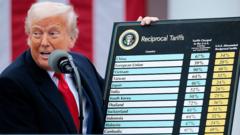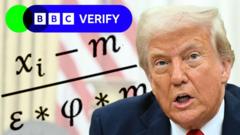**The recent announcement sets off a wave of uncertainty in global markets as experts weigh the positive and negative consequences of the tariffs.**
**Trump's Tariff Strategy: A New Era of Trade Policy?**

**Trump's Tariff Strategy: A New Era of Trade Policy?**
**As President Trump unveils an ambitious new tariff plan, reactions vary on its potential impacts.**
The economic landscape shifted dramatically on April 3, 2025, as President Trump introduced sweeping tariff measures aimed at reshaping international trade dynamics. This new system seeks to replace the traditional framework of import taxes with a fresh strategy that he argues will reinstate fairness in global trade.
These tariffs, described as potentially groundbreaking, are designed to pull manufacturing jobs back to American soil. “We’re going to see a boom,” Trump confidently asserted while global markets faced significant downturns, grappling with the repercussions of such a radical policy shift. The president contended that this approach was a necessary response to years of unfair trading practices by other nations.
However, experts and economists have raised alarms over the impracticalities of the tariffs. Predictions suggest that the measures could actually hinder U.S. economic growth, inflate consumer prices, and complicate operations for businesses relying on global supply networks.
Central to the new tariff system are two primary components. The first is a baseline tariff of 10 percent that broadly affects nearly all imports, exempting only those from Canada and Mexico. The second component introduces a reciprocal tariff targeting 57 nations that Trump claims impose high tariffs on American goods, a measure intended to level the playing field.
As these developments unfold, the broader implications of Trump's tariff initiative remain uncertain, raising critical questions about its long-term effects on the U.S. economy and global trade relations.
These tariffs, described as potentially groundbreaking, are designed to pull manufacturing jobs back to American soil. “We’re going to see a boom,” Trump confidently asserted while global markets faced significant downturns, grappling with the repercussions of such a radical policy shift. The president contended that this approach was a necessary response to years of unfair trading practices by other nations.
However, experts and economists have raised alarms over the impracticalities of the tariffs. Predictions suggest that the measures could actually hinder U.S. economic growth, inflate consumer prices, and complicate operations for businesses relying on global supply networks.
Central to the new tariff system are two primary components. The first is a baseline tariff of 10 percent that broadly affects nearly all imports, exempting only those from Canada and Mexico. The second component introduces a reciprocal tariff targeting 57 nations that Trump claims impose high tariffs on American goods, a measure intended to level the playing field.
As these developments unfold, the broader implications of Trump's tariff initiative remain uncertain, raising critical questions about its long-term effects on the U.S. economy and global trade relations.





















